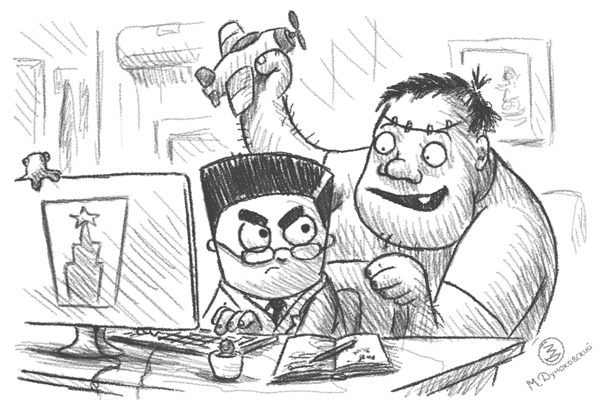How Grace Hopper made computers more accessible

Programmer Grace Hopper is not a household name, but she played a key role in transforming computers from inaccessible computing machines into user-friendly tools. In specialist circles, she is called “incredible Grace”, “grandmother of software” and even “queen of code”. Hopper received these high-profile titles thanks to her work on the first compiler, as well as one of the first programming languages. We talk about her life and inventions.
Mathematics instead of family life
Grace Hopper was born in 1906 in New York. Only the father worked in the family, he was an insurance agent, and the mother was a housewife. According to Hopper, she inherited her mathematical mindset from her.
Many future innovators show extraordinary abilities in early childhood, and little Grace was no exception. At the age of seven, the girl became interested in how alarm clocks work.
Grace began her first mechanical exploration and disassembled seven pieces. The mother supported her daughter’s interest, but asked her to stop at studying one alarm clock.
Later, Grace decided to go against social expectations and get a technical education. In 1924, on her second attempt, Hopper entered Vassar College, the first educational institution for women in the United States.

She studied mathematics and physics, and in 1928 successfully received a bachelor's degree in these specialties. Hopper then attended Yale University. There in 1934 she defended her doctorate with a thesis on irreducible polynomials and ring theory. Hopper's scientific advisor was the famous Norwegian mathematician Oistin Ore.
After becoming a doctorate in mathematics, Hopper returned to her alma mater, Vassar College, and began her teaching career. But this career path did not last long – in 1939, World War II began, to which the United States became a participant two years after the Attack on Pearl Harbor.
“The Computer Bible” and a bug – military service and the first steps in programming
Hopper was not able to immediately contribute to the victory of the Allies. At 34, Hopper was too old to enlist in the military. The scientist was also underweight – she had a thin build.
At the same time, more and more men entered military service, leaving their jobs. Fields like mathematics were in dire need of qualified specialists, which played into Hopper's favor.
In 1943, through the WAVES (Women Accepted Volunteer Emergency Service) program, she was able to join the US Navy Reserve.
Hopper first attended Reserve Cadet School at Smith College in Massachusetts and graduated top of her class.

After a year of training, already an ensign (analogous to our second lieutenant), Hopper was sent to the Bureau of Artillery Computing Projects at Harvard University to work on the Mark I, a sequence-controlled automatic computer. In fact, it was the first American programmable computer.
Working for the military did not bother her. On the contrary, she described the experience as “the most complete freedom I have ever had.” Moreover, in those years the army and navy were the most promising places of work for many innovative scientists (hello Oppenheimer!).
Hopper called The Mark I was an “impressive beast” and “the most beautiful gadget” she had ever seen. The Mark I was 17 m long, 2.5 m high, and occupied a separate room at Harvard.
The term “computer programming” did not exist back then, but that’s how you could describe the tasks Grace performed at that time. The team worked on complex calculations for the military, such as calculating missile trajectories and creating firing range tables for new anti-aircraft guns.
Hopper worked under computer pioneer Howard Aiken. In 1946, he commissioned Hopper to compile a manual for the use and operation of the Mark I.

In its early years of operation, the Mark I relied on improvised methods among crew members. Hopper's task was quite ambitious – to combine disparate knowledge about the car and create detailed professional instructions.
Because of the volume of data, the scientist compared the project to creating a “computer bible.” The result was a 500-page book. Hopper meticulously described every aspect of the Mark I's physical components, operation, and maintenance.
The manual contained detailed instructions on how to program the machine, which actually did his first ever textbook on computer programming.
After successfully completing the task, Aiken appreciated Hopper's merits and made her his deputy. They subsequently co-authored several articles on the Mark I. Aiken continued building computing machines with the Mark II and Mark III, and Hopper worked on his team.
During that period, Hopper unknowingly had a hand in the emergence of the terms “bug” and “debugging” in computer usage. In 1947, during testing of the Mark II, a beetle flew into the computer case, causing the machine to malfunction.
In English, a beetle is a bug, or a bug. Hopper pasted the insect into her tech diary and wrote “first bug discovery,” meaning the beetle. But the term entered history precisely as an error or malfunction in the operation of computer equipment.

Laziness is the engine of progress: creating the A-0 compiler
In 1949, Hopper was offered a position as chief mathematician at the technology company Eckert-Mauchly Computer Corporation. Founders John Mauchly and John Presper Eckert built a computer called ENIAC for the US Army in 1946.
Hopper was invited to work on UNIVAC I, America's first fully electronic digital computer for general, not just military, use. In 1950, the corporation sold its assets to Remington Rand, after which Hopper headed the department for the development of automatic programming.
The UNIVAC I could process more information than the Mark I, which greatly appealed to Hopper. Computer could perform 455 multiplications per second and store about a thousand in its memory on mercury delay lines.
In addition, she had more freedom in the commercial field. Hopper took advantage of this and experimented with new ways to use the computer for coding.
The scientist was interested in automatic programming. She later recalled that while working, she was too lazy to rewrite programs to fit the hardware settings again and again.
So in 1952 the A-0 compiler appeared. You need to understand that the programs of that time were a set of mathematical expressions that had to be processed by several other programs. It was long and difficult.
The A-0 compiler made it possible to translate a high-level computer language into binary, that is, machine language, using just one program. In parallel with Hopper, others were developing a similar program. For example, in the same 1952, the Autocode compiler was launched at the University of Manchester under the leadership of Alec Glennie.
But the term “compiler” was created by Hopper and her team at Remington Rand. The functionality of A-0 does not quite match what is meant by this term today. Rather, it can be called a program loader and linker.
Still, it was a breakthrough and an important milestone in the development of programming. Hopper laid the foundation for the creation of modern programming languages that simplified communication between people and computers, allowing complex tasks to be completed with a minimum number of commands.
After A-0, updated versions were released – A-1, A-2 and so on. The first customers received the A-2 compiler by the end of 1953. Remington Rand has provided them the source code of A-2 and suggested making improvements to UNIVAC.
Grandmother of COBOL – one of the early programming languages
Meanwhile, Hopper continued to entertain the idea of writing programs in words rather than symbols. In her opinion, the programming language should be closer to everyday English, and not to binary code. This would make the use of computers more understandable for the general user.
Computers were just beginning to spread among ordinary users – mainly in companies and enterprises. The lack of engineering or mathematical education seemed to them an insurmountable obstacle to using computers.
Hopper saw great potential for computers in business applications, such as payroll, so she continued her research and endeavors.

Remington Rand management did not share Hopper's vision. However, she didn't care. The scientist’s statements were divided into quotes, and one of them reads: “People are allergic to change. I try to combat this, which is why I have a clock on my wall that goes counterclockwise.”
In 1956, her team launched FLOW-MATIC, the first programming language to use verbal commands. The innovation of this language was the syntax, where data and operations with them were separated.
Only transactions were expressed verbally, data was entered through pre-printed forms. FLOW-MATIC became the basis for COBOL.
COBOL emerged from the Conference on Data Processing Systems Languages, held in the spring of 1959. It was carried out by the CODASYL organization, the main goal was to create a standardized programming language for business.
The basis for COBOL was FLOW-MATIC Hopper, another source of influence was COMTRAN from IBM. COBOL was created by the efforts of many people, not just Hopper, but the fact that her brainchild was at the heart of the language earned her the nickname “Grandmother of COBOL.”
Hopper was involved in the development of this language, both in the military and in the civilian sphere. She also worked on developing a compiler for COBOL.

The language uses English keywords, and its syntax is close to complete sentences in English. Among the advantages is the easy readability of programs.
Among the disadvantages is cumbersomeness. For example, what is expressed in C-like languages as y = x;, in Cobol will look like this – MOVE x TO y.
COBOL was also criticized due to its lack of structure. Dutch scientist and one of the developers of the concept of structured programming Edsger Wijkstra even saidthat using Cobol is “brain damaging” and teaching it is a “criminal offence.”
Despite all its shortcomings, COBOL became widespread in the 1960s and 1970s. More and more computers were blinking in every corporate office, just as Hopper wanted.
By the 1980s, COBOL was considered obsolete, but remained popular. As of 1997, the COBOL code processed 90% of the world's financial transactions and 75% of commercial transactions.
COBOL is still used today, especially in the United States, mainly to support existing applications. In August 2023, he even came out in 15th place in popularity among all programming languages.
There are many reasons for the popularity of the language. Decades of use have made COBOL reliable and stable. With its help, you can process large amounts of data without the need for expensive equipment. COBOL is compatible with other languages and technologies such as Java, C#, SQL, XML, etc.
The Legacy of Amazing Grace
Throughout her career in the computer industry, Hopper remained in the Navy Reserve. In 1966, when the scientist turned 60, the US Navy offered her a lifetime contract. So Hopper set about improving the fleet's computer programs.
The scientist promoted the idea of replacing large centralized computer systems with networks of many small computers. This approach allowed any user, regardless of his location on the network, to access shared databases.
This innovation ultimately led to the creation of the Internet, which was initially developed in the military field and for military purposes.

In addition, Hopper was involved in developing standards for testing computer systems.
Her dedication to her work earned her the admiration of Hopper's subordinates, who dubbed her “Amazing Grace.” And in 1985 she was awarded the rank of rear admiral. At that time, Hopper was 79 years old.

Even after her final retirement in 1986, Hopper continued to work. She gave public lectures and conducted consultations for IT companies.
Grace Hopper died in 1992. By that time, computers were no longer rare, at least in the United States. And they understood English and other human languages, just as the scientist dreamed.
Hopper was known for her quirky personality. She was skeptical about military drill and believed that it was better to ask for forgiveness afterward than to wait for permission. There was a pirate flag in Hopper's office, adding to the irony that she served in the Navy.
In 1986, Hopper was awarded the Distinguished Service Medal. And after her death, a missile frigate was named after Hopper. USS Hopperthe Cray XE6 “Hopper” supercomputer and college at Yale.

Hopper played a particularly important role in making the computer field more open to women. Since 1994, a conference of women computer scientists named after her has been held. There are scholarship funds in Hopper's name that support girls and women in programming.
During an interview with TV host David Letterman asked Hopper, how did she know so much about computers? To which the scientist replied that she knew nothing. Being among the pioneers, Hopper largely acted on a whim and did not receive the support of her leadership in everything, both in corporations and in the navy. For example, her life's ambition is to teach computers to understand human language, not just numerical commands.
But she succeeded in this. Although programming still requires special skills and training, Hopper's ideas have made important contributions to making programmers' jobs easier. And ordinary people do not need to study the intricacies of binary code just to use a computer.
Useful from Online Patent:
→ What is the Register of Domestic Software?
→ Can a foreign company enter its program into the Register of Domestic Software?
→ How IT companies can maintain zero VAT and get included in the Register of Domestic Software





